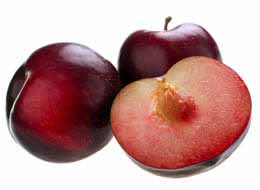Pluots: Your Guide to a Unique Hybrid Fruit
- By The FruitGuys
- Reading Time: 4 mins.

Pluot (PLOO-awt)—it’s fun to say and great to eat! This sweet-tart fruit is part plum, part apricot, and totally delicious. Here’s a quick look at the pluot basics.
What are Pluots?
If you cross-pollinate a plum and an apricot, you get a plumcot; crossing a plumcot with yet another plum creates a pluot. That means pluots are more plum than apricot—somewhere between three-fifths and three-quarters plum.
Developed in the late 20th century by Midwest biologist Floyd Zaiger, pluots have a vibrant tart-sweet flavor, smooth skin, and a juicy interior that makes them perfect for snacking. They’re high in vitamins C and A and, like most fruits, are a good source of dietary fiber. When choosing a pluot, look for one that’s slightly firm but has a gentle give when you squeeze it.
Taste Profile of Pluots
What really sets pluots apart is their flavor. They have a delightful sweetness, often described as candy-like, with subtle floral and fruity notes. Their higher sugar content compared to plums and apricots gives them a more intense sweetness, while their low acidity keeps the flavor smooth and balanced. When ripe, pluots give off a light-but-sweet aroma that hints at the deliciousness inside.
Varieties of Pluots
Pluots are as pleasing to the eye as they are to the palate. Their thin, glossy skin comes in a wide range of colors—from deep purple to golden or even multicolored, depending on the variety. The color of the flesh can also vary, ranging from pink and red to white, yellow, or orange. Each pluot variety has its own unique characteristics. Here are a few of our favorites.
- Dapple Dandy: Sometimes marketed under the name Dinosaur Egg®, this variety has a unique look with mottled tan and red skin.
- Flavor Grenade: This variety stands out for its green skin, elongated shape, and “explosive” flavor. Can you guess how it got its name?
- Black Kat: The name of this variety is right on the money—with striking blue-black skin and pale golden flesh, it’s reminiscent of a yellow-eyed cat.
- Crimson Heart: This fan-favorite fruit looks ready for Valentine’s Day with its slight heart shape and bright red flesh.
Want farm-fresh fruit?
We've got you covered.Nutritional Profile of Pluots
Petite pluots are perfect for snacking. Here’s a detailed look at the nutritional benefits you’ll gain from one serving (two raw pluots, or 154 grams).
Calories: Pluots have just 69.3 calories per serving, making them a light and healthy snack option.
Protein: Each serving provides 1 gram of protein, which is essential for muscle repair and growth.
Fat: Pluots are fat-free! That makes them a heart-healthy choice.
Carbohydrates: Two pluots have about 16.9 grams of carbohydrates, primarily from natural sugars (15 grams). They’re a good source of energy that won’t spike your blood sugar as much as processed sugary snacks.
Dietary Fiber: Two pluots pack in 2 grams of fiber, so snacking on them can boost your digestion, help lower your cholesterol, and keep you full.
Vitamin C: Oranges aren’t the only fruit full of Vitamin C—just one serving of pluots can provide 24% of what you need in a day. This all-around great vitamin supports immune function, skin health, and iron absorption, helping protect your body from infections.
Vitamin A: One serving of pluots will give you about 10% of the Vitamin A you need in a day. That means pluots support good vision, skin health, and more.
Calcium: One serving of pluots sneaks in about 9.24 milligrams of calcium, which helps keep your bones healthy and strong.
Iron: One serving of pluots only has around .19 milligrams of iron, but a little is better than none! Iron helps your blood transport oxygen and can help prevent anemia, a blood disorder triggered by a lack of functional red blood cells.
Sodium: Pluots are sodium-free, so you can enjoy them without worrying about increasing your blood pressure or risk of hypertension.
Cholesterol: Last but not least, pluots are cholesterol-free, too! That’s more great news for your heart health.
Storage Tips
To keep your pluots fresh and tasty, you need to ripen and store them correctly. Follow these quick and easy steps for the best results.
- Ripening: Store whole pluots at room temperature until they give slightly when you squeeze them. That means they’re ripe and ready to eat.
- Storing Whole Pluots: If you don’t want to eat your ripe pluots right away, store them in the fridge until you’re ready to snack.
- Storing Cut Pluots: Remove the pits from the ripe pluots and cut the fruit into chunks or wedges. Then, place the pieces in a food-safe container with a tight seal and refrigerate them to keep them fresh and flavorful.
FAQs
- How do I know when pluots are perfectly ripe for eating?
Pluots are ripe and ready to eat when their skin yields slightly to gentle pressure. The skin should be vibrant and free from major blemishes, with a sweet fragrance. - Are pluots genetically modified organisms (GMOs)?
No, pluots are not GMOs. They’re a natural hybrid of plums and apricots, developed through traditional cross-pollination techniques by biologist Floyd Zaiger. - How do pluots differ from plumcots?
While both pluots and plumcots are hybrids of plums and apricots, pluots are more plum-dominant, making them sweeter and juicier. Plumcots are an earlier hybrid with a more balanced 50-50 genetic split between plums and apricots.


